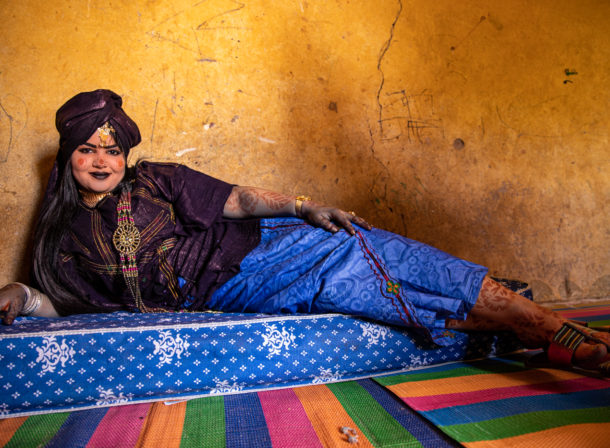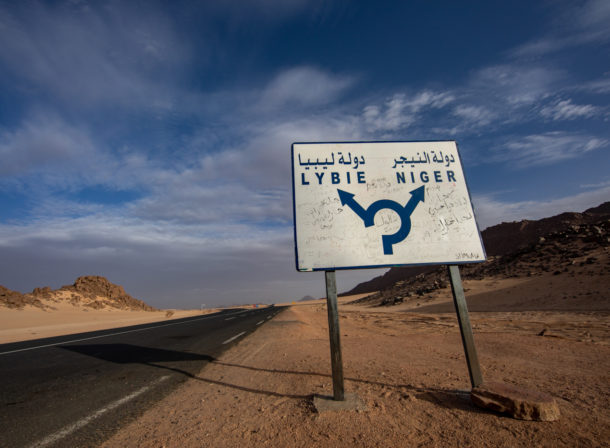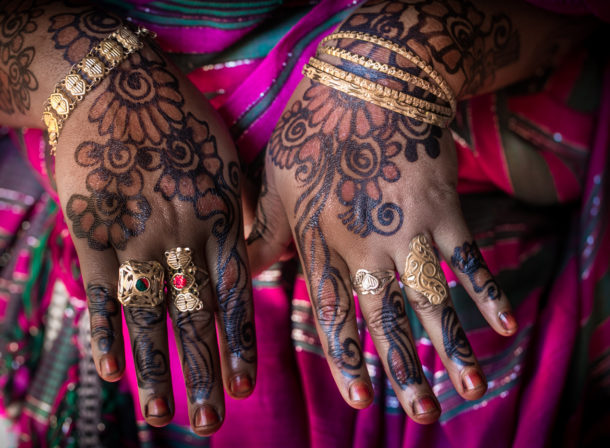The Tuareg, estimated at 3 million people (1.5 million according to official figures), live in the central Sahara desert at the fringes of the Sahel, a territory that covers the periphery of five different countries, namely Libya, Algeria, Niger, Mali and Upper Volta (now Burkina Faso). They are at the same time nomads, semi-nomads, sedentary, and city dwellers.
The question of territory continues to be an issue since the beginning of 20th century as explained by the famous anthropologist Hélène Claudot-Hawad in her renown research. Prior to the establishment of the colonial order, the Tuareg saw themselves as people of a geographical area delineated by the following boundaries: to the northeast Ajjer, to the northwest Ahaggar, to the southeast Aïr and to the southwest Tademekkat, to which the Azawagh, the "middle" has been added.
What should be emphasized is that these political and geographic boundaries resemble the structure of a tent. The tent is in essence what symbolizes the matrilineal aspect of the Tuareg society.
By being identified with her tent, which she owns, inherits from her mother and passes on to her daughters, the woman has always been an essential pillar of this body to which she gives meaning. However, the organization of Tuareg society has neither been respected by colonization which has tribalized and divided it, severely narrowing its identity, nor by the nation states where their territory is currently located, defined by fixed borders and closed boundaries. These developments are entirely contradicting the very essence of the Tuareg conception of territorial delineation by the symbolic tent.
Blessed with mineral wealth (oil, gas, uranium, etc.), these territories continue to attract the commercial interests of great powers. In areas where Tuaregs do not have rights to exist in their traditional ways of life, they have settled in or around cities since the 1970s and 1980s. In Tassili N’Ajjer alone, which is the theme of this reportage, 80% have given up their ancient nomadic lifestyle.
For those who still have a nomadic lifestyle, women continue to be the mainstay of society.
Ténéré means desert in Tamachek, the Tuareg’s language. It designates both the place where emptiness reigns and where the survival of human beings and livestock is harsh. A space of freedom which shields the territories and shifting borders of nomads. A zone of vestiges erased by time, where all living things must fight for their survival. It is to the ténéré that the Tuareg identify, whether they are nomadic, semi-nomadic or sedentary. It is from it that they learn that no being or object can exist without the protection of a shelter. Here, near Tin Merzouga.
AmaDal amadal: “The earth is what protects, what keeps, what nurses”. This Tuareg maxim, quoted by French anthropologist Hélène Claudot-Hawad, an acknowledged specialist, illustrates the Tuareg’s particular bond to the land. Hence their respect for nature, and the reason that drives them to protect it so that it can "continue to beget and carry life on its back".
Camp of Tin Tahadeft. To speak of their home, of all the people who live there, including the descent and the lineage, the Tuareg use only one term: éhen (the house). Éhen is the tent, but it is also the wife, since she is the owner of the house that will house the couple after their marriage – she also owns the cattle. By extension Éhen also applies to all women who constitute the matrilineality of kinship. The feminine axis, which makes it possible to transmit the rights and inalienable goods which, like the tent, will ensure the survival of the community.
In this camp, the kitchen is a closed space. Relatives living in an oasis deliver the food supplies. On the menu, taguella targuia, the traditional Tuareg dish, semolina bread cooked in ashes. It is then mixed with a vegetable sauce made from tomatoes, onions and peppers.
Women as well as men prepare the tea Tuaregs insist that to be good "it takes time, embers and friends". Tea is prepared in three stages: the first is bitter like life, the second sweet like love, the third light like the last breath. Time devoted to its preparation makes the tea ritual important, because it welcomes the spirit and connects it to life, to action. It opens to philosophical reflection and engagement. Raising the teapot high while keeping the glass close to the ground oxygenates the drink and makes it foam. It also emphasizes the elegance of the gesture. Then, to express your pleasure, it suffices to drink it in very small sips.
The tent is the heart of a Tuareg’s life, the interior space where one lives, as opposed to the exterior, where one faces the harshness of existence. The tent belongs to the woman to whom each of her children is linked, as filiation comes to pass in a matrilineal manner. Built during the wedding, the tent must harbor a few objects from the bride’s own mother, thus creating a symbolic link with the original shelter, which is transmitted from one generation to another and allows in the process the ancestors to be part of daily life.
When a woman selects her husband from outside her clan or tawshit (the clan is a group of people who have a common ancestor), she sets up her tent in her husband's camp, thus creating a territorial enclave. Her tent continues to be the symbol of her lineage. In the event of a divorce, she leaves with her tent, her dowry and even the animals she has inherited, with the exception of the camels, the men’s property. As for the children, if they are small, they follow their mother to the latter's original camp, to the maternal uncle.
They can read the desert, depending on the shape and color of the dunes, find their landmarks by observing the shadows of the rocks or even of the stars. Knowledge that tends to be lost, because the youngest aspire to a more modern and urban lifestyle.
The Tuareg believe that no living thing can exist without the protection of a shelter. However, the shelter itself is of no use if it is not near water. In other words, what connects living things - animals, humans and plants - to the cycle of life is the path that leads from shelter to water. The Tuareg know the sources and the water points, especially those who live in camps and small villages, which are not supplied. Every two or three days they go near a water source, often several hours away, on the back of a donkey, to fill their jerry cans and return to the Tin Tahadeft camp.
Without the dromedary, the Tuareg would be lost. These animals are both a means of transport and a beast of burden, used for drought or racing. Their wool provides protection, their meat feeds and the female supplies milk. Hence its hefty cost (between 2,600 and 3,000 euros). Its breeding is now regrettably in decline.
Afara Oasis. The tindi is a musical ceremony, which involves mostly women. A wooden mortar drum, the tindi, is the instrument at the heart of it. While playing the drum and swinging her head and body, a woman goes into a trance; a second woman, at her side, begins to sing poetic songs, while all those around them accompany the duo by clapping their hands and singing. These songs are addressed to geniuses. These have no name, but it is their nature that gives the melody its rhythm. During this time, men embark on camel races, two by two, while uttering guttural cries.
The matrilineal principle - of transmission from mother to daughter - works for inheritance, land rights and property considered as an inalienable asset. In addition, the women keep the cattle from which they obtain fresh milk, curds, butter and cheese. They also use the hides for crafts. Tuareg women transmit tales and legends to their children. They teach them tifinagh, the traditional writing system used in this part of the desert, and tindi, the songs which will be sung in groups on the wedding day.
This beauty, dressed in Nigerian fashion, is single. She hopes to find a soul mate during the three days of the wedding celebrations. Although Muslim, the Tuareg woman rejects polygamy.
The new generation is more and more attracted by the sedentary life, which no longer leaves to the tradition and the rituals the place which they once had. Studying to gain access to skilled jobs and settling in the city are part of today’s dreams.
Women transmit social rank to their children through the veil. A noble mother assures nobility to all her descendants, regardless of the father’s rank. But if the latter is noble and the mother is a slave, the child will be one of the slaves.
The future bride comes from Tasset, she settles in another camp, that of her future husband. Upon leaving her mother's tent, the young bride moves with her own tent and all the household utensils she needs, but also with her pets, her herd of goats, and her servants. This separation is called tazlit.
In Afara, where the wedding will be held, the bride's tent is already set up. A present from her mother, it will mark the continuity of the line. All of these "little tents" handed down by the mother to her daughters form the big tent or mother's tent (éhen n ma). This is why in absolute terms, Tuareg society should be interpreted as bringing together all the tents, while the eldest woman embodies the central pillar of this society, surrounded by subsidiary stakes. Tuareg tribes are very hierarchical, and the balance of power creates strong inequalities.
Installation in the camp of the future husband in Afara. Six ornate pillars support the woman's tent. The Tuareg believe that it is important for the wife to be economically independent. Living without being dependent on her husband guarantees the dignified and proud character of the whole lineage she represents. Once they are married, the husband gives part of his flock to his wife: in times of drought, this issue is the subject of negotiation between spouses.
Among the Tuareg, Islam coexists with other popular beliefs. A mosque of odds and ends, in Tasset, in the middle of the desert.
Tuaregs feel the character of the desert according to the color of the sand or the shape of the dune. They can find their way around by following the shadows of the rocks or the movement of the stars. Prayer near the Tin Merzouga erg.





























































Enjoyed your colorful photography and descriptions. My husband and I will be traveling to the Sahara around Djanet in March for a few weeks. As it is Ramadan we will regretfully not be able to attend any weddings.